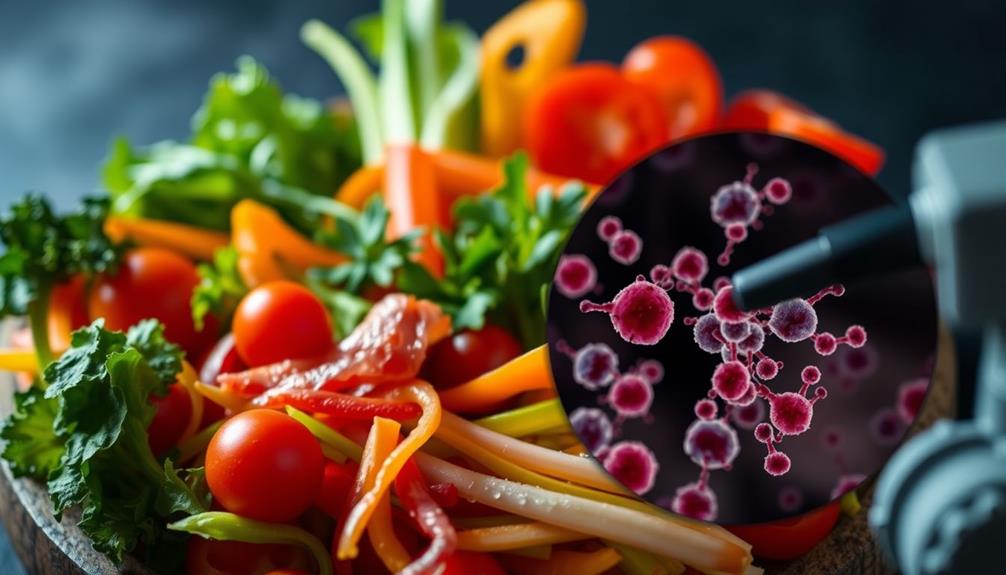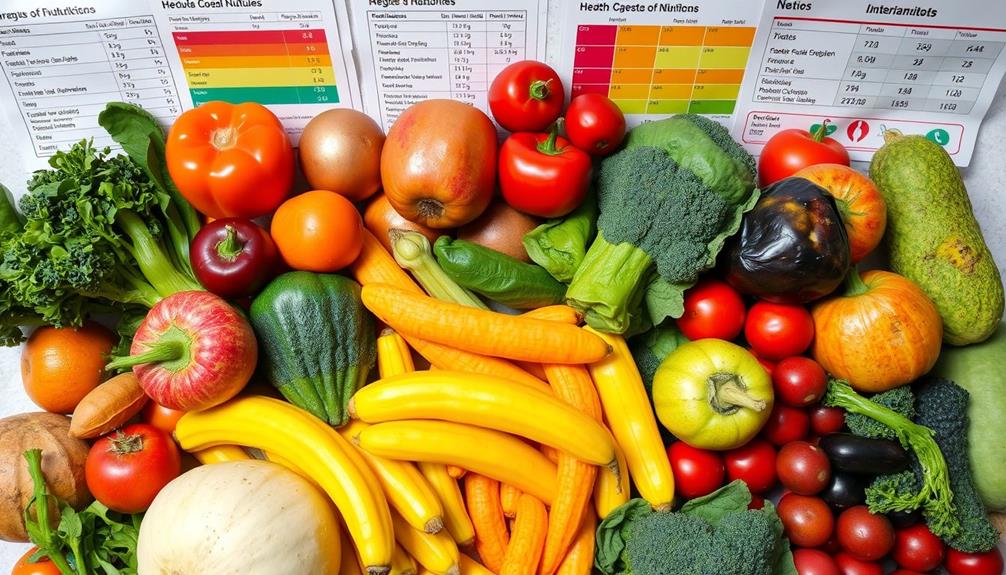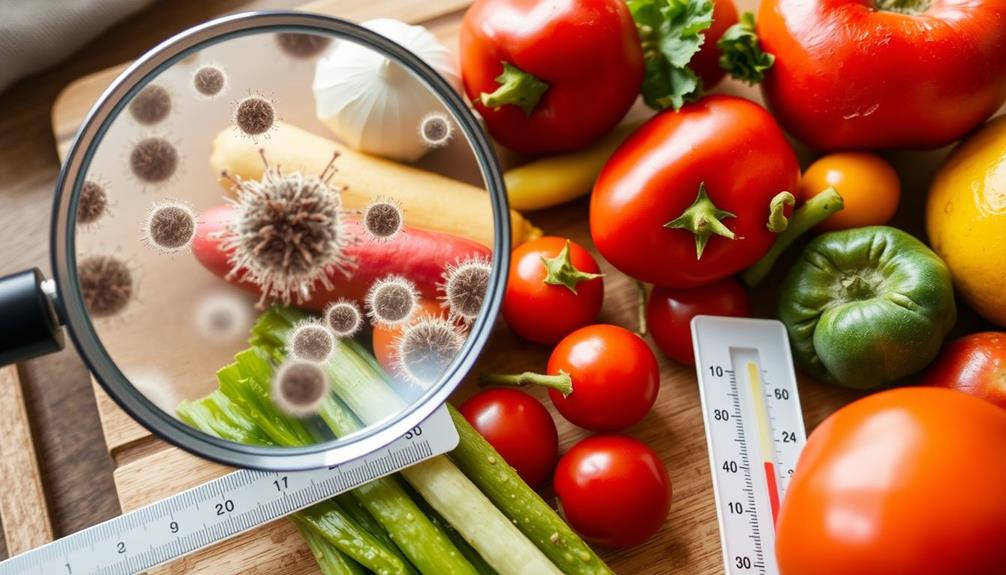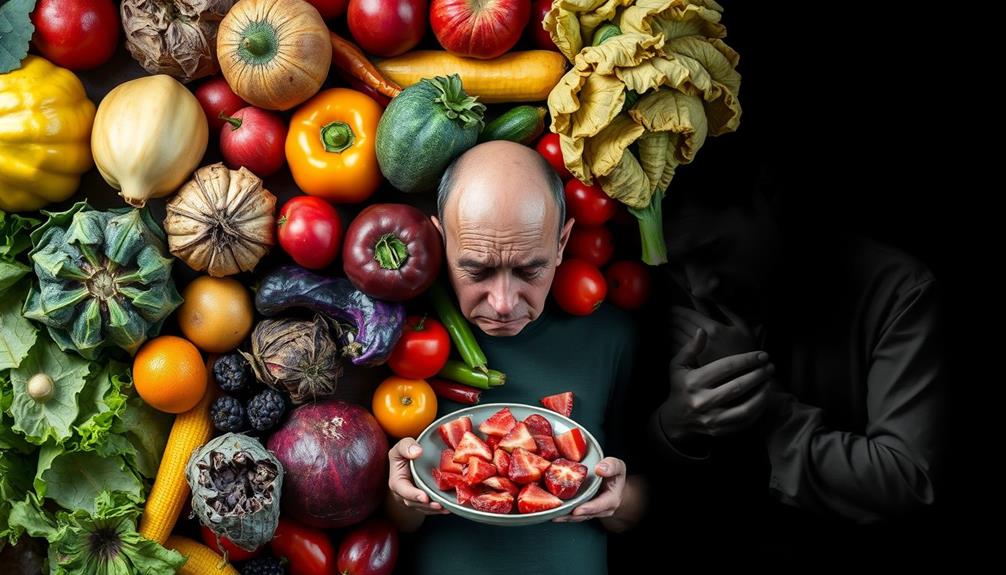Eating raw food can put you at risk for serious health issues. Raw animal products like meat, eggs, and seafood may contain harmful bacteria such as E. coli and Salmonella, which can cause foodborne illnesses. You should also be cautious with raw sprouts and unwashed fruits and vegetables, as they can harbor bacteria too. Additionally, a strict raw diet can lead to nutrient deficiencies, impacting your health negatively. Proper meal planning and food safety practices are essential. If you're curious about specific risks and safe consumption tips, you might find more information useful. Raw food and diarrhea risks are particularly prevalent when it comes to consuming raw animal products such as sushi and rare steak. It’s important to be aware of the potential dangers and take necessary precautions, such as making sure to properly cook meat and thoroughly wash fruits and vegetables. By practicing safe food handling and being mindful of the risks associated with raw food, you can reduce the likelihood of experiencing negative health effects. If you have any concerns or questions about raw food and diarrhea risks, it’s always best to consult with a healthcare professional for personalized advice.
Key Takeaways
- Consuming raw animal products can lead to foodborne illnesses from harmful bacteria like E. coli and Salmonella, especially in high-risk groups.
- Raw eggs significantly increase the risk of Salmonella infection, highlighting the importance of thorough cooking.
- Nutritional deficiencies, particularly in vitamin B12 and iron, can occur with a raw food diet if not properly balanced.
- Cooking enhances the bioavailability of certain nutrients, making them more accessible for absorption compared to raw foods.
- Proper food safety practices, such as washing produce and avoiding cross-contamination, are crucial when consuming raw foods.
Understanding Raw Food Risks
When you dig into a plate of raw food, it's essential to understand the hidden risks that come with it. Consuming raw foods, especially raw animal products like meat, eggs, and dairy, can expose you to harmful bacteria such as E. coli and Salmonella. These bacteria can lead to severe foodborne illness, making it important to be cautious.
Additionally, the significance of discussing personal risk factors with healthcare providers can also apply to dietary choices, as some individuals may be more susceptible to foodborne illnesses based on their health status discussing personal risk factors.
Raw seafood, including sushi and ceviche, also poses risks, particularly for high-risk groups who should avoid these dishes altogether.
Additionally, raw sprouts are notorious for harboring bacteria in warm, humid conditions, which can lead to outbreaks of foodborne illnesses.
You mightn't realize that uncooked flour contains pathogens too, so it's crucial to cook any flour-based products thoroughly before eating.
Even raw fruits and vegetables aren't entirely safe; they can carry traces of harmful bacteria from handling and processing. That's why proper washing techniques are important to reduce contamination risks.
Bacterial Contamination Concerns

Many people don't realize just how vulnerable raw foods can be to bacterial contamination. Foods from animal sources, like raw meat, poultry, seafood, and eggs, are particularly high-risk. Pathogens such as Salmonella and E. coli can lead to severe foodborne illnesses if these foods aren't handled properly.
For instance, consuming raw eggs poses a significant risk of Salmonella infection, which can cause gastrointestinal distress. Additionally, it's important to take into account cold medications overview that may help alleviate symptoms if you do experience illness after consuming raw foods.
Even fruits and vegetables, often thought to be safe, can harbor bacteria from food handlers. This makes proper washing essential to minimize the risk of foodborne illness.
Sprouted seeds and nuts, while nutritious, can develop harmful bacteria in warm, humid conditions, raising safety concerns even after washing.
Raw seafood, such as oysters or ceviche, can also contain viruses and bacteria from their aquatic environments, necessitating proper cooking to eliminate these pathogens.
It's vital to stay aware of these risks when choosing to eat raw foods. By understanding the potential for bacterial contamination, you can make informed decisions about your diet and prioritize your health.
Specific Dangers of Raw Foods

Raw foods can pose considerable health risks, particularly due to the potential for foodborne illnesses. When you consume raw meats, like pork and poultry, you expose yourself to harmful bacteria. For instance, Salmonella contamination in raw eggs is a serious concern, making thorough cooking vital for safety.
Additionally, consider that some frozen treats, like traditional ice cream, can also carry risks if not prepared or stored properly ice cream safety considerations.
Raw fish, commonly found in sushi or ceviche, can harbor dangerous parasites and bacteria. If you're part of a high-risk group, it's best to avoid these foods altogether.
Additionally, raw kidney beans contain natural toxins that can lead to severe digestive issues, unless properly cooked.
Even fresh produce isn't safe from foodborne illnesses, as contaminated vegetables can carry harmful bacteria. It's essential to wash your raw foods thoroughly, but this doesn't always eliminate the risks.
Nutritional Deficiencies and Considerations

If you're considering a raw food diet, you might face vital nutrient shortages, especially with vitamin B12 and iron.
Cooking not only makes certain nutrients more accessible but also helps balance your overall diet.
It's important to pay attention to these factors to maintain your health and energy levels.
Essential Nutrient Shortages
Adopting a raw food diet can lead to significant essential nutrient shortages that may impact your health. While raw foods offer benefits, you might face deficiencies in key nutrients essential for your well-being.
For instance, essential oils such as eucalyptus oil can support respiratory health, which might be necessary if you experience respiratory issues related to nutrient deficiencies.
Here are some potential shortages to take into account:
- Vitamin B12: Primarily found in animal products, this vitamin is critical for nerve function and red blood cell formation.
- Iron absorption: The absence of heme iron from meat can hinder your body's ability to absorb iron effectively, leading to potential anemia.
- Omega-3 fatty acids: Important for heart and brain health, these essential fats are often lacking since fish and certain seeds might be excluded or consumed minimally.
- Vitamin D: Essential for calcium absorption and bone health, vitamin D is typically obtained from fortified foods and animal products, leaving you at risk for deficiencies.
Additionally, a reliance on raw foods may result in inadequate protein intake, important for muscle maintenance and repair.
Without a varied and balanced approach to plant-based foods, you might expose yourself to health risks that could be challenging to overcome.
Bioavailability of Nutrients
Understanding the bioavailability of nutrients is vital for anyone contemplating a raw food diet. While raw foods can provide many vitamins and antioxidants, certain nutrients mightn't be as accessible to your body. For instance, cooking can enhance the bioavailability of nutrients like lycopene and beta-carotene, while some water-soluble vitamins may be lost.
Additionally, incorporating a balanced budget for your food choices can help guarantee that you're purchasing a variety of nutrient-dense options financial health. If you're on a raw food diet, you might face deficiencies in essential nutrients such as vitamin B12, iron, omega-3 fatty acids, and protein. This can lead to health risks, including fatigue and muscle weakness.
Additionally, a study found that long-term raw food vegetarians often have lower bone mass, indicating potential risks to skeletal health from inadequate calcium and vitamin D intake. The high fiber content in raw foods can also affect digestibility, making it harder for your body to absorb certain nutrients.
Consequently, you might need to take into account supplementation to avoid these deficiencies. Careful meal planning is significant to guarantee you're meeting your nutritional needs while following a raw food diet, as neglecting these aspects can result in significant health problems over time.
Food Safety Practices

Ensuring food safety is essential when it comes to enjoying raw foods without health risks. By following key practices, you can considerably reduce the chances of encountering harmful bacteria and foodborne illnesses. Here are some important tips to keep in mind:
- Always wash fruits and vegetables thoroughly under clean water to eliminate potential bacteria.
- Use separate cutting boards for raw meats and other foods to prevent cross-contamination.
- Regularly clean cooking surfaces and utensils to minimize contamination risks.
- Be cautious with certain raw foods, like sprouts and unpasteurized dairy, which carry higher risks.
It's imperative to wash your hands after handling raw foods to prevent spreading bacteria.
Remember, cooking animal products to specific internal temperatures is essential, but if you're consuming them raw, the same level of caution applies.
Stay aware of how you handle raw meats and dairy to avoid foodborne illnesses.
Preparing Raw Foods Safely

When it comes to preparing raw foods, taking specific steps can make all the difference in maintaining safety. First, always wash raw fruits and vegetables thoroughly under clean running water to eliminate bacteria and reduce the risk of foodborne illness. Proper hygiene is essential, so don't forget to wash your hands and surfaces frequently during food preparation.
Individuals with mental health conditions, such as Borderline Personality Disorder, may find emotional regulation challenging, which can impact their cooking practices and food choices.
To prevent cross-contamination, use separate cutting boards for raw animal products and other foods. This separation is critical to keep harmful pathogens from spreading. If you're using raw nuts or seeds, remember that sprouting can enhance their nutritional value, but it also increases the risk of bacterial contamination. So, wash them properly before consumption.
When dealing with raw animal products, it's important to cook them to the recommended internal temperatures: 160°F for meat, 165°F for poultry, and 145°F for fish. These temperatures guarantee that harmful bacteria are killed, making the food safe to eat.
Evaluating the Raw Food Diet

As you explore the raw food diet, it's important to recognize both its appealing aspects and potential drawbacks. Advocates often tout various health benefits, such as increased energy and potential weight loss, but it's important to understand the risks involved.
For instance, while a raw food diet may be rich in antioxidants, consuming unprocessed foods can lead to nutrient deficiencies if not balanced properly.
- Nutrient deficiencies: A diet focused solely on raw foods can lead to missing essential vitamins and minerals.
- Foodborne illnesses: Consuming raw animal products increases the risk of contamination with harmful bacteria like E. coli and Salmonella.
- Cooking advantages: Cooking can enhance nutrient bioavailability, making certain nutrients more accessible.
- Social isolation: The restrictive nature of the diet can lead to challenges in social settings.
While a raw food diet may offer increased energy and potential weight loss, these health risks necessitate careful meal planning. Striking a balanced intake of both raw and cooked foods can help mitigate nutrient deficiencies.
Frequently Asked Questions
What Are the Dangers of Eating Raw Food?
Eating raw food can expose you to harmful bacteria, increasing your risk of foodborne illnesses. Certain foods, like sprouts and raw meat, are particularly dangerous, especially for those with weakened immune systems. Stay cautious!
What Happens to Your Body on a Raw Food Diet?
Your body dances between energy and vulnerability on a raw food diet. You'll feel energized, yet risk nutrient deficiencies and digestive woes. Embrace variety to nourish your health while savoring nature's vibrant, unprocessed bounty.
Why Raw Food Is Not Healthy?
Raw food isn't healthy because it can expose you to harmful bacteria and toxins. You might miss essential nutrients too, leading to deficiencies that affect your immune system, energy levels, and overall well-being over time.
Is Raw Food High Risk?
"You reap what you sow." Yes, raw food can be high risk. You expose yourself to harmful bacteria and potential foodborne illnesses, especially with raw animal products, undercooked meats, and contaminated fruits or vegetables. Stay cautious!
Conclusion
To sum up, while raw foods can be nutritious, they come with health risks that shouldn't be ignored. For instance, imagine someone who regularly eats raw sprouts, only to find themselves hospitalized with a severe case of food poisoning. This scenario highlights the importance of understanding food safety and the potential dangers of raw diets. By taking precautions and preparing raw foods safely, you can enjoy their benefits without compromising your health. Always stay informed and cautious!

















